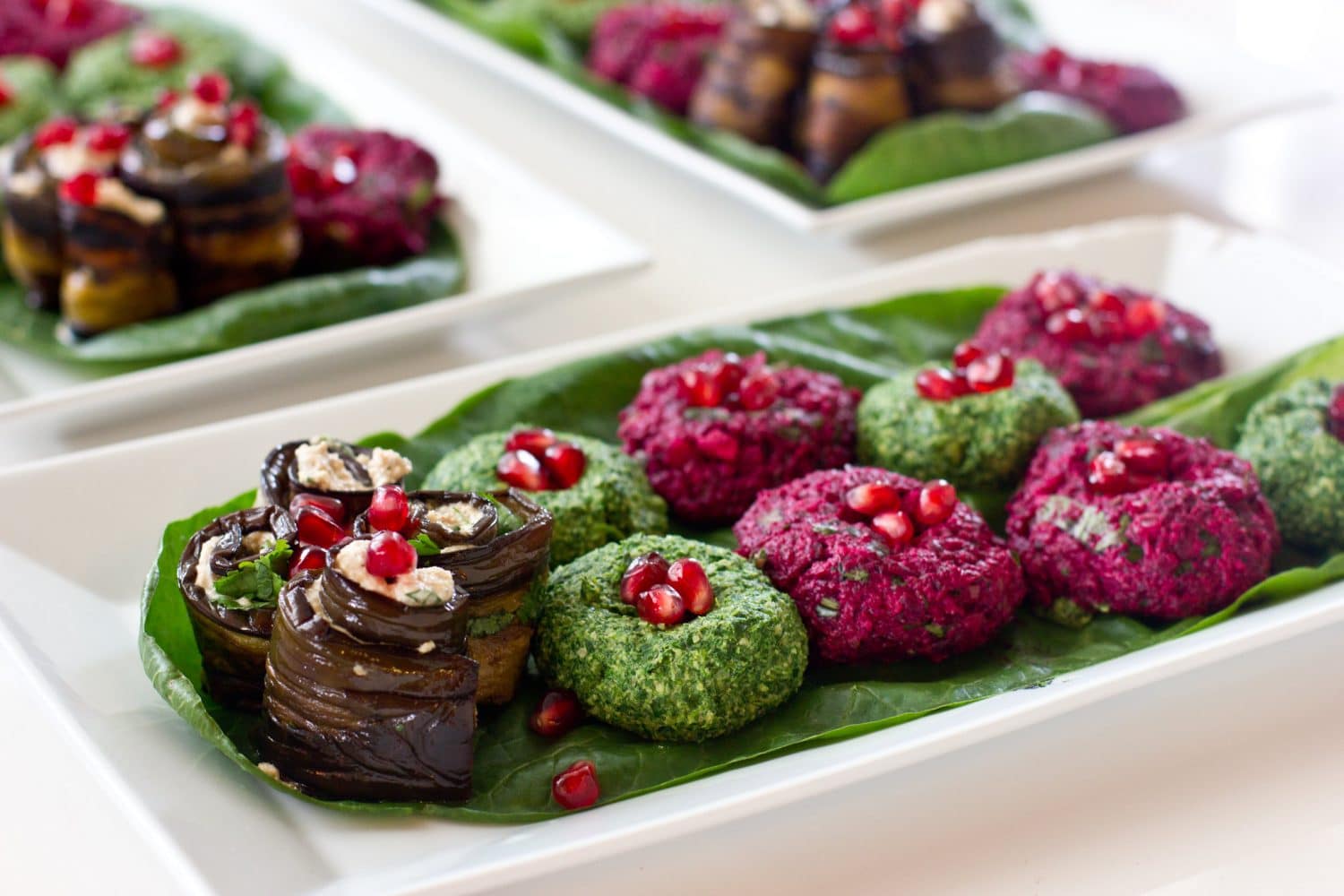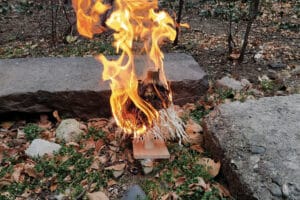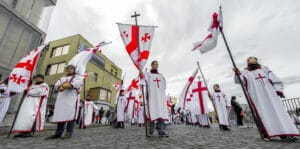Georgia’s Christmas traditions of chichilaki and alilo reflect the deeprooted importance of tradition, sustainability, and religious expression in Georgian culture. Chichilaki are a unique, eco-friendly alternative to the Christmas tree that have been present in Georgian culture since ancient times. Meanwhile, alilo is a caroling tradition when costumed Georgian take to streets to sing religious hymns together. Christmas is one of Georgia’s most important holidays – one that revolves around family, food, and religious traditions. Gifts are typically saved for New Year, meaning that Christmas retains a much purer spiritual mood.
Although all of these traditions were suppressed or made more difficult under the Soviets and Tsarist rule, they are today making a vibrant comeback as Georgia seeks to revive and express its relatively newfound independence. For more on how Georgia celebrates its holidays, see our Guide to Georgian Holidays.
Chichilaki: the Ancient, Eco-Friendly Georgian Christmas Tree
By Sophia Monte
Chichilaki are a Georgian Christmas tradition rich in history and symbolism. They resemble a small coniferous tree although they are usually thought of locally as representing the beard of St. Basil the Great. They are traditionally decorated with dried fruits, candy, berries, and flowers as well as kalpi and bokeri. Kalpi is the decorative ring of ivy that wraps around the chichlaki, while bokeri are decorative bread rings baked with flour, eggs, and cheese that symbolize life and fertility.
Chichilaki are created by shaving dried hazelnut or walnut branches and often range in size from 20 cm to 3 meters. They are, however, usually not more than one meter tall as they are most often placed on a table. The tallest chichilaki ever recorded was 4 meters tall. Pruned walnut or hazelnut branches are first soaked in water and then dried in front of a stove. This makes “shaving” the stick into its distinctive shape easier.
Chichilaki originated in the western provinces Guria and Samegrelo of Georgia. The trees are often small and sometimes used as a centerpiece to a khoncha. The khoncha is a decorated board or basket containing sweets, pomegranates, nuts, wine, and ritual breads. It developed in the eastern Caucasus and is today better associated with Azerbaijan and Armenia. It is a sort of cornucopia that represents bounty and good fortune.
There are many interpretations of the underlying symbolism of chichilaki, and its resemblance to the beard of St. Basil the Great, who, according to tradition, brings presents to Georgian children on Christmas, is perhaps the most oft-cited, but is only one explanation. Others liken the curly shavings of chichilaki to the rays of the sun and believe chichilaki to bring bountiful harvests and a better future. The crown of the tree “collects” the troubles of the past year, which would give more meaning to the fact that the chichilaki are ceremoniously burned on the day before the Georgian Orthodox Epiphany on January 19th. The ashes of the chichilaki are then scattered, symbolizing the removal of the previous year’s troubles from the household.
Not all Georgians will burn the chichilaki, however. Some store the tree in their wine cellars with the belief that the “tree of life” will protect the wine. This practice stems from pre-Christian tradition in Georgia. The western provinces of Guria and Samegrelo in Georgia, where chichilaki originated, were once associated with pagan religious practices centered on the “Tree of Life” or the “World Tree.” Early chichilakis were adorned with a ring of reeds at the top, which may have been an additional symbolism of the sun. This was later replaced by a cross, thus joining ancient pagan traditions with Christian ones.
During the time of the Soviet Union, the sale of chichilakis was banned. While Georgians were allowed to keep certain aspects of their culture, chickilaki were considered to be a religious symbol, and therefore forbidden. After the fall of the Soviet Union, the tradition of chichilaki has experienced a resurgence in popularity as Georgians seek to revive and celebrate old traditions.
Some people make their own chichilaki every year, but more often today it is made by semi-professionals who then sell them in holiday markets.
Sometimes the chichilaki is set up in the home alongside a green New Year’s tree. However, many now use only the chichilaki. Georgia’s forests are legislatively protected and unregistered cut trees carry heavy fines. Chichilaki also appeals to many Georgians for its environmental friendliness. Thus, chichilaki are often far more practical and can be easily reused. Many argue that they are more humane and sustainable as well – as they are made only from branches cut to improve the health of the living tree.
In 2020, the president of Georgia proposed for chichilaki to be included in UNESCO’s Intangible Cultural Heritage list, alongside Kalandoba, a Gurian celebration for the Old-New Year on the evening between January 13-14. In Guria, this is often celebrated as the New Year, with imporatance over December 31.
Cherished by Georgians, the chichilaki that successfully survived Soviet times will continue to be preserved by Georgians as an important Christmas and New Year’s tradition.
Alilo: A Caroling Tradition that Draws Crowds
By Nathan O’Hara
Among the world’s Christmas traditions, alilo stands out as a radiant gem. Referring to the tradition of Georgian caroling, alilo has been a distinctive tradition since the first millennia. If a visitor is in Georgia for Georgia’s Orthodox Christmas celebrations on January 7th, it would be hard to miss the alilo tradition as a procession of costumed individuals march down the streets of major cities and villages alike. This article will mainly focus on alilo as a caroling tradition, as well as the alilo procession specifically in Tbilisi (for which the more proper name of “Alilooba” will be used).
What is Alilo?
Similar to the koliada caroling traditions of various Eastern and Central Slavic nations, or even western caroling practices, the tradition of alilo is meant to herald the birth of Jesus Christ by filling the streets with song. The word “alilo” is known in English as “Alleluia”, a common Christian phrase meant to glorify God.
“Alilo” refers to the practice of Georgian Christmas caroling and in general, and Georgian carols themselves are called “alilo.” While many variations of the carols exist, the core of each centers around the resounding proclamation of “alilo” (“alleluia”) with themes of redemption, joy, community, and charity.
History
While possessing similarities with other cultural Christmas celebrations, the Georgian caroling tradition is much older than its aforementioned Slavic and western counterparts. This is perhaps to be expected as Christianity spread to the Caucasus very early in its history and, in fact, Armenia and Georgia were the world’s first and second officially Christian states.
Alilo traces back to approximately the fifth century- at least three centuries before the first official Christianizations of the Slavic nations. The tradition of alilo is nearly as old as Christianity in Georgia and has become ingrained in Georgian culture.
The fact that this tradition has lasted over a millenia points to its durability and importance in Georgia. Georgia, although long a Christian state, has rarely been and independent state and has often been divided between other empires. Muslim rulers did not smile on the loudly Christian practice of alilo – and neither did Georgia’s Russian rulers. In 1811, the Russian Orthodox Church stripped the Georgian Orthodox Church of its autocephaly and began a period of Russification of Georgian church life which, in part, resulted in alilo becoming less popular. However, this paled in comparison to the Soviet period, when alilo was banned outright. As part of its anti-religious campaign, the Soviet government sought to erase Christmas as a national celebration, employing its arsenal of propaganda and state violence to make it so. Aside from the efforts of a few ethnomusicologists to record and preserve the tradition, alilo was, for decades, driven underground and remembered only behind closed doors. It was officially re-established as a public ritual by Patriarch Ilia II in 2000 (the Georgian Orthodox Church had actually regained autocephaly during the Russian revolution of 1917 and the Soviets had allowed this to remain).
Today, alilo is a popular celebration that is celebrated by Georgians of all walks of life, which truly speaks to Georgia’s unique heritage and history, spanning age and even religious divides.
Tbilisi Alilooba
Alilo processions are more formally called “alilooba.” These had humble beginnings as small community events, where a few people would go door to door singing alilo and receive gifts such as eggs, representing new life and fertility. Over time, this evolved into a national celebration of grand processions. These differ across the country but do have many things in common. For instance, they center around children and children most often lead the processions. Also, people often arrive in costumes and carry symbols ranging from small to enormous.
Tbilisi, as the capital, hosts the largest such procession every year, which has now taken a regular form. The procession is led by children linked arm-in-arm and dressed in white, symbolizing the angels who came to herald the birth of Jesus Christ. These children are followed closely by people dressed as shepherds. Next are oxcarts, upon which sit children guarding empty baskets that are meant to collect donations. Following these are large figures representing animals such as camels and elephants meant to represent what the transport the magi used when they arrived to bring gifts. Finally, rows of people dressed in red-lined white gowns carry banners donning the Georgian flag, carried upright to emphasize the cross depicted on it, and the cross of St. Nino- the female saint who evangelized the region in the fourth century. This last group symbolizes Georgia and its Christian faith. Priests flank the procession with blessings, incense, and large Orthodox icon of the Nativity. Most significantly, alilo is sung throughout the procession, proclaiming phrases such as “Merry Christmas!” and “Christ is born!”.
The procession does not always have the same route in central Tbilisi. It may march down Rustaveli Avenue, or go through the Rose Revolution and Independence Squares. Nevertheless, alilooba always ends at the Holy Trinity Cathedral, where ringing bells greet the procession and where Patriarch Ilia II greets the revelers before leading a Christmas day service. Then, the collection of donations is finalized for distributions to places like orphanages or nursing homes.
It is important to note that Georgia is an extremely diverse country, and alilo is in no way uniform throughout it. In addition, while the Tbilisi alilooba is the most famous, most major cities in Georgia host a similar celebration. There are many different variants of alilo and celebrations span across different regional customs. For over a millenia, the core of alilo as a joyous and triumphant holiday tradition remains, as well as its reflection of the distinctiveness and warmness of the Georgian nation.
You’ll Also Love

Pkhali – The Healthy Georgian Pâté
Pkhali (пхали in Russian; ფხალიin in Georgian), made from finely chopped and cooked vegetables mixed with spicy walnut sauce, is one of the most popular traditional Georgian dishes. It is usually garnished with pomegranate seeds and sometimes served alongside eggplant rolls that also feature spicy walnut filling. Almost any vegetable can be used to make […]

A Guide to Georgian Dairy Products
Georgian cuisine, known for its unique flavor combinations, is also known for several unique dairy products. Like similar dairy products around the world, these originated from the same need to preserve the nutritional and caloric value of milk. With several local twists to the preparation process, however, including the use of “spontaneous starters” – or […]

Berikaoba: Georgia’s Spring Festival Rises Again
Berikaoba is defined by its monstrous-looking masks, good-natured pranking, games and performances of strength, freely shared food and wine, and general festive atmosphere. Although the festival was nearly lost to the passage of time, locals, foreigners, and Georgians from other corners of the country now flock to the Kakhetian villages of Didi Chailuri and Patara […]

Sameba Holy Trinity Cathedral: Tbilisi’s Marvel of Pride and Identity
If one has a clear view of the skyline in central Tbilisi, it’s hard to miss the towering figure of the Holy Trinity Cathedral. Better known locally as Sameba, the cathedral is an architectural marvel – the tallest church in Georgia and the third-tallest Eastern Orthodox church in the world. Today it is a symbol […]

Georgia’s Story of Identity: Heroes, Memory, and Meaning
What shapes Georgian national identity? The answer is complex and personal, but one key element is the Georgian national narrative. This includes the heroes and pivotal events taught in schools, the places central to the nation’s collective memory, and the language and beliefs that frame its worldview. A national narrative goes beyond history: it is […]













